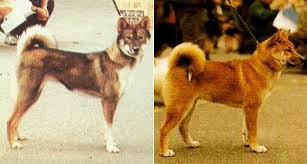The Sanshu Dog and its origins can be traced back to the 1920s in Japan. It is believed that this breed was created by crossing different breeds like the how Chow Chow, Akita, Phu Quoc Dog and other Japanese Spitz varieties, but this has never been scientifically proved.

The breed has been commonly used for herding, guarding the cattle, hunting and as a watch dog or guard dog, because of its territorial and protective character. The breed was versatile because of its ability to withstand even the harshest conditions.
The Sanshu Dog is today a popular breed, although rare outside its native country, and is used as a companion or as a working dog.
The Sanshu is a small to medium sized dog and resembles a smaller Akita in appearance. It is very robust and comes in two size varieties, with the larger one standing 55 cm while the smaller one measuring around 45 cm in height. For this breed, the weight ranges from 19 to 25 kilograms.
The dog has a wedge shaped head, with a tapering muzzle, almond shaped eyes, usually dark colored and small, triangular ears, held in an erect position.
The coat is coarse, short, and abundant. The colors include gray, tan, red, pied, white and various combinations, like salt and pepper or black and tan.
Sanshus are known for their hard working nature and energetic personality. They are great guard dogs as well as good companions. They thrive on strong relationships with their owners and will always be eager to please them. The dogs are playful and very gentle with children as well as with other people.
Being an intelligent dog, it will respond very well to training as long as a kind and positive attitude is used. The key of success is to establish dominance respect and trust but also patience. The dog reacts well around other dogs or smaller pets, but it is still advisable that it is socialized with other persons or pets from a young age.
It is not suited for indoor living, as it is highly energetic and enjoys walks as well as other outdoor activities. When the dog lacks attention or exercise, it can develop behavioral deviations, like barking, destroying property, chewing, whining as well as ignoring basic commands and training. The characteristic Spitz type coat needs a lot of care and grooming. Brushing must be done almost daily thus preventing tangling, as well as maintaining the dogs beautiful appearance.
The breed is known to be generally healthy, but some conditions may appear, including hip and elbow dysplasia skin allergies, obesity or bloating. The best way to keep these problems at bay is to go to periodical medical exams, performed by a veterinarian specialized in this breed, or asking for help from an authorized breeder.
Now that you have read the basic facts about this rare but exceptional breed, you will know if the Sanshu Dog is the dog that you and your family are looking for.




